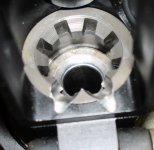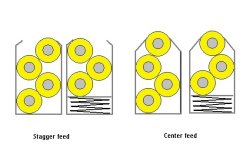I think mostly because George Luger, Browning, Saive, Hugo Borchardt, the Koucky brothers, Gaston Glock and other were simply inconsiderate wretches who cared little for Machineguntony's mangled thumbs.
But more seriously it's a good question. I don't know the complete answer. In the overwhelming majority of pistols the rounds are loaded by pushing down and back (not just down, or down and to the side) and the feed lips retain the round in the mag securely and this mangles some thumbs while reloading when the spring is tough and strong or the follower sticky. This is true for both single and double stack mags.
Saive was the first to design a double stack mag and his was built this way. Meaning that as the rounds fed upward the mag tapers till only one round sits alone at the top and is retained by two lips of the mag rather than a single lip. In some rifle mags only one lip actually keeps the round in place while the pressure of the spring and the round below and to the side of it keep the round located and secure. The follower in these is not flat but staggered. It is flat in single stack mags.
So what sets a pistol's action and design apart from a carbine, smg, or semi auto rifle that could influence this?
One thing is that the mag loads through the grip frame on the pistol and the angle and thickness of the mag is a factor in the gun's design.
The second important factor, seems to me, is that the slide of the pistol moves back and forth. It's action and construction is quite different from the bolt of the carbine. Slides are generally thinner than rifle receivers.
The third thing may be where the round, in the mag, sits in relation to the feed ramp. It's been said already that to get a mag in a pistol where the top round is not on center line of the bore in the Y axis (side to side) to feed reliable you'd need a wider feed ramp. It would also be effected by where the round sits in relation to the chamber on the z axis, meaning how low the round sits in the gun. In a 1911 the round sits low and bumps it's way into the chamber, in a Berretta 92 it's almost a straight shot. So this could make a difference.
tipoc





